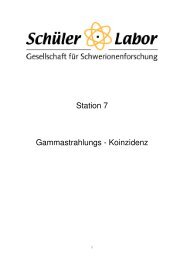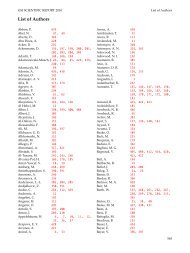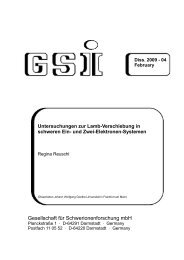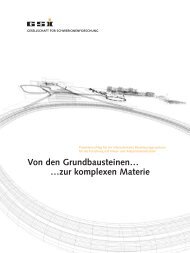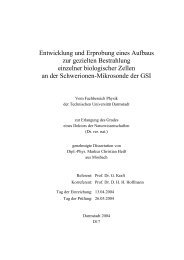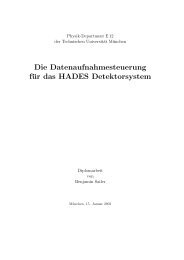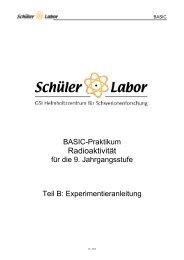CBM Progress Report 2006 - GSI
CBM Progress Report 2006 - GSI
CBM Progress Report 2006 - GSI
You also want an ePaper? Increase the reach of your titles
YUMPU automatically turns print PDFs into web optimized ePapers that Google loves.
Detector Developments <strong>CBM</strong> <strong>Progress</strong> <strong>Report</strong> <strong>2006</strong><br />
Achievements of CMOS Pixel Sensors for the <strong>CBM</strong> Micro-Vertex Detector<br />
S.Amar-Youcef 1 , A.Besson 2 , G.Claus 2 , M.Deveaux 1,2,3 , A.Dorokhov 2 , W.Dulinski 2 , S.Heini 2 ,<br />
A.Himmi 2 , K.Jaaskelainen 2 , Ch.Müntz 1 , F.Rami 2 , J.Stroth 1 , I.Valin 2 , and M.Winter 2<br />
1 J.W.Goethe Universität, Frankfurt; 2 IPHC and Université L.Pasteur, Strasbourg; 3 <strong>GSI</strong>, Darmstadt<br />
It was already established that CMOS sensors provide<br />
the single point resolution and reduced material budget required<br />
for the ambitionned MVD vertexing performances.<br />
Achieving these performances in the <strong>CBM</strong> running conditions<br />
is however challenging, especially because of the<br />
required radiation tolerance and read-out speed. Important<br />
steps addressing these issues were made in <strong>2006</strong>. Moreover,<br />
a new generation of real size sensors was fabricated,<br />
to be used for thinning and system integration studies [1].<br />
Fast read-out architecture<br />
The fast read-out architecture developped for the <strong>CBM</strong><br />
MVD extrapolates from the MIMOSA-8 prototype, designed<br />
for the ILC vertex detector. The sensor includes<br />
correlated double sampling micro-circuits and discriminators,<br />
and delivers discriminated binary signals [2]. Its<br />
single point resolution was evaluated in Summer <strong>2006</strong> at<br />
the CERN-SPS. A resolution of 7 µm was found, i.e.<br />
slightly better than the intrinsic resolution (∼ 7.2 µm) reflecting<br />
the pixel pitch (25 µm). This result indicates that<br />
integrated ADCs may not be mandatory to get a single<br />
point resolution as small as ∼ 5 µm, provided the pixel<br />
pitch is kept small enough (typically 18 µm). This perspective<br />
coincides with the need for a small pitch in order<br />
to enhance the sensor tolerance to bulk damage, by reducing<br />
the distance the signal charges have to cross in order to<br />
reach a sensing diode.<br />
MIMOSA-8 was manufactured in TSMC 0.25 technology,<br />
which features a 7 µm thick epitaxial layer. The<br />
chip was translated in <strong>2006</strong> into the AMS 0.35 OPTO technology<br />
(MIMOSA-16), where the layer is ∼ 11 µm thick.<br />
Besides a larger signal amplitude, MIMOSA-16 also includes<br />
other improvements: enhanced tolerance to ionising<br />
radiation (MIMOSA-15 pixel architecture [2]), as well as<br />
pixels incorporating high gain amplification micro-circuits.<br />
Since it is not yet clear whether integrating an ADC at<br />
the end of each column may be avoided, various ADC architectures<br />
are being developed, in synergy with the ILC requirements.<br />
The first ADC prototypes (5-bit Wilkinson and<br />
4-bit successive-approximation ) designed at IPHC were<br />
submitted to fabrication in Autumn <strong>2006</strong>. Prominent design<br />
challenges include compactness, aspect ratio, signal<br />
processing speed and power dissipation.<br />
Radiation tolerance<br />
Radiation tolerance studies started with MIMOSA-15 in<br />
2005 [2] were complemented in <strong>2006</strong> with ∼ 5 GeV/c e −<br />
beam tests at DESY.<br />
28<br />
A sensor exposed to an integrated dose of ∼ 1 MRad<br />
(obtained with a 10 keV X-Ray source) was observed to<br />
still exhibit a S/N ratio of 19 (it was 27 before irradiation),<br />
and a detection efficiency of ∼ 99.9 % at a coolant temperature<br />
of -20 ◦ C (180 µs integration time). These performances<br />
validate the pixel architecture implemented against<br />
parasitic leakage current generated by ionising radiation.<br />
MIMOSA-15 chips irradiated with 1 MeV neutrons<br />
were studied on the same beam. A sensor exposed<br />
to ∼ 2·10 12 neq/cm 2 still exhibited a detection efficiency<br />
above 99 % at a coolant temperature of -20 ◦ C. For a fluence<br />
of ∼ 6·10 12 neq/cm 2 , the detection efficiency dropped<br />
to ∼ 80 %. Given the available room from improvement,<br />
these results indicate that fluences 10 13 neq/cm 2<br />
per MVD layer are likely to be tolerable.<br />
Improvements include pixel design optimisation and fabrication<br />
process choices which reduce the diffusion path of<br />
the signal electrons before reaching a sensing diode. Efforts<br />
were made in <strong>2006</strong> towards this goal, on the one hand<br />
by designing pixels featuring L-shaped sensing diodes and<br />
on the other hand by fabricating a sensor in a BiCMOS<br />
process featuring an epitaxial layer with a relatively high<br />
resistivity expected to allow for substantial depletion.<br />
New generation of real size sensors<br />
The most attractive fabrication technology characterised<br />
so far is the AMS-0.35 OPTO process. Excellent tracking<br />
performances were obtained with 5 consecutive small prototypes<br />
fabricated in this technology since late 2003, which<br />
was chosen for the sensors currently developed for short<br />
term tracking applications (STAR HFT, EUDET beam telescope).<br />
The latter triggered an engineering run in <strong>2006</strong>,<br />
which was used to produce simultaneously a real size,<br />
multi-purpose sensor, intended to equip a first generation<br />
MVD demonstrator. The sensor, which features 256x256<br />
pixels of 30 µm pitch, is read out in 1 ms. It was fabricated<br />
in 2 different versions, one where the epitaxial layer<br />
is ∼ 11 µm thick (default value) and one where it is expected<br />
to be 16 µm (new commercial option). The engineering<br />
run was also motivated by the possibility to study<br />
the fabrication yield and to have a stock of real size sensors<br />
available for thinning and system integration studies.<br />
References<br />
[1] M.Winter, “Status of CMOS sensor R&D”, talk presented at<br />
the <strong>CBM</strong> collaboration meeting, Sept. 2005, <strong>GSI</strong>/Darmstadt;<br />
[2] 2005 <strong>GSI</strong> Annual <strong>Report</strong> and references therein.



